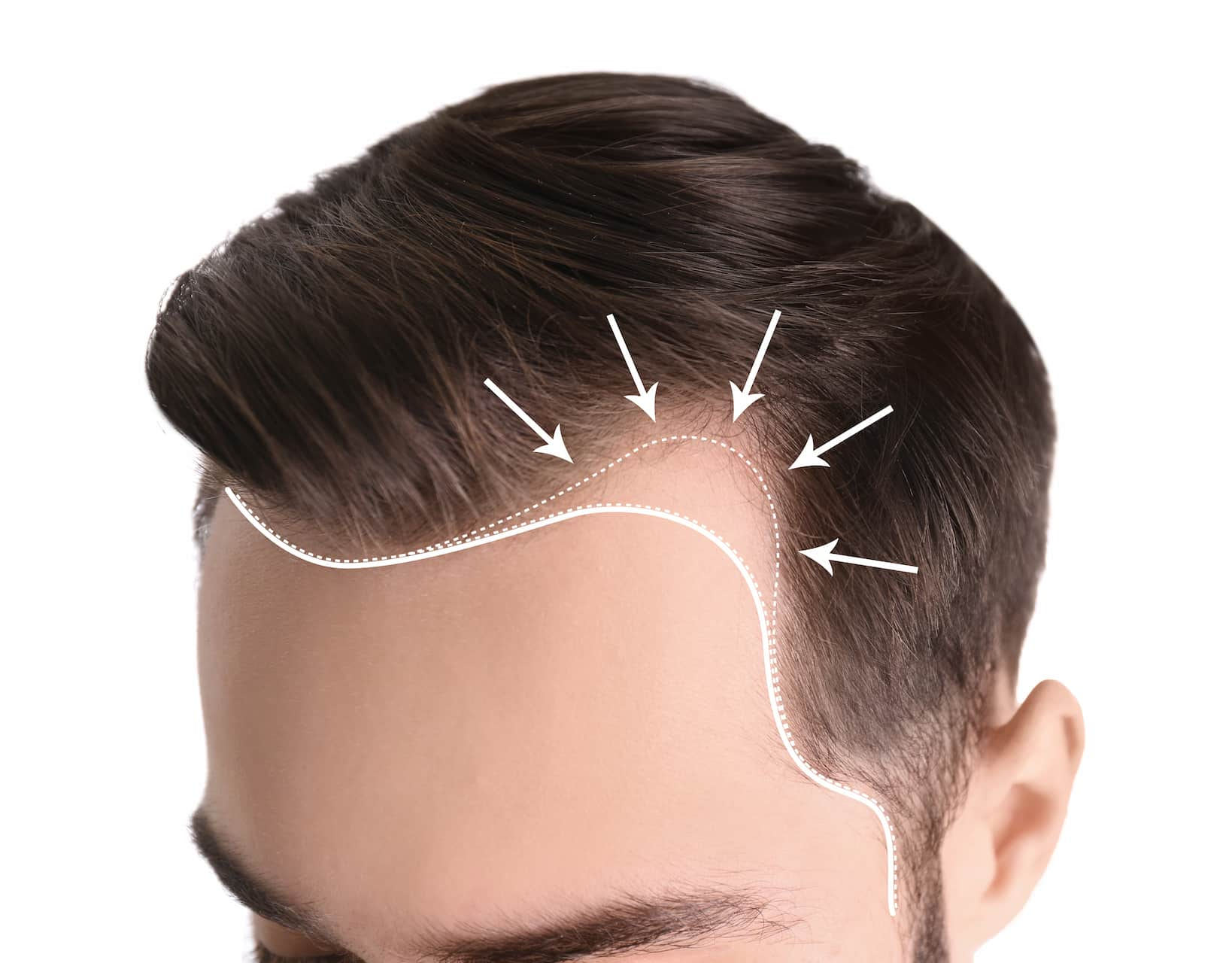
M-Shaped Hairline
A receding hairline can be a distressing sight for anyone, but when the hairline forms an “M” shape, it can be particularly alarming. An M-shaped hairline is a type of receding hairline that forms an M shape, leaving the hairline higher in the middle and lower on the sides. This type of hairline is more common in men, but women can also experience it.
In this blog post, we will explore the causes of an M-shaped hairline, available treatments, and solutions to help you deal with this condition.
What is an M-Shaped Hairline?
An M-shaped hairline is a type of receding hairline that forms a distinctive pattern in the shape of the letter “M” when viewed from the front. This pattern is characterized by a recession of the hairline at the temples, which causes the hairline to move higher in the middle of the forehead and lower on the sides. This pattern is often more common in men, but women can also experience it.
The M-shaped hairline is a common type of hair loss pattern, particularly in men. It is often an early sign of male pattern baldness, which is the most common cause of hair loss in men. Male pattern baldness is a hereditary condition that affects many men as they age. It is caused by genetics, hormonal changes, and aging. As men age, their hair follicles shrink and produce thinner hair, which can lead to hair loss. The hairline may begin to recede at the temples and form an M-shaped pattern.
While male pattern baldness is the most common cause of an M-shaped hairline, there are other factors that can contribute to this condition. For example, stress, nutritional deficiencies, and certain medications can also cause hair loss and a receding hairline. In women, hormonal changes such as those that occur during pregnancy or menopause can also cause an M-shaped hairline.
The M-shaped hairline can be a distressing sight for many people, particularly if it occurs at a young age. It can affect a person’s self-confidence and self-esteem. Fortunately, there are several treatments and non-surgical solutions available to help deal with this condition.

Causes of an M Hairline
The most common reason for an M-shaped hairline is male pattern baldness, which is a hereditary condition that affects many men. Male pattern baldness is caused by genetics, hormonal changes, and aging. As men age, their hair follicles shrink and produce thinner hair, which can lead to hair loss. The hairline may begin to recede at the temples and form an M-shaped pattern.
Male pattern baldness is caused by a combination of genetic and hormonal factors. The hormone dihydrotestosterone (DHT) is a major contributor to male pattern baldness. DHT is a derivative of testosterone and is produced in the hair follicles, skin, and prostate gland. DHT causes the hair follicles to shrink and produce thinner hair, which can lead to hair loss. This process is called miniaturization.
Men who are genetically predisposed to male pattern baldness are more susceptible to the effects of DHT. The gene for male pattern baldness is inherited from both parents, and it can be passed down to male and female offspring. Men with a family history of male pattern baldness are more likely to experience an M-shaped hairline and other types of hair loss.
While male pattern baldness is the most common cause of an M hairline, there are other factors that can contribute to this condition. For example, stress can cause hair loss and a receding hairline. This is because stress can disrupt the hair growth cycle and cause hair to enter the resting phase prematurely. When hair is in the resting phase, it is more likely to fall out.
Nutritional deficiencies can also contribute to hair loss and an M-shaped hairline. A lack of essential vitamins and minerals, such as biotin, zinc, and iron, can weaken the hair and cause it to fall out. Eating a balanced diet that is rich in these nutrients can help promote healthy hair growth and prevent hair loss.
Certain medications can also cause hair loss and a receding hairline. For example, chemotherapy drugs can cause hair to fall out, and some medications used to treat high blood pressure and depression can cause hair loss as a side effect. If you are experiencing hair loss while taking medication, it is important to talk to your doctor to determine if the medication is the cause and if there are alternative treatments available.
In women, hormonal changes can also cause an M-shaped hairline. For example, hormonal changes that occur during pregnancy or menopause can cause hair loss and a receding hairline. In some cases, birth control pills can also contribute to hair loss.
Treatments for an M-Shaped Hairline
There are several treatments available for an M hairline, depending on the cause of the hair loss. If male pattern baldness is the cause, there are two FDA-approved medications that can help slow or stop hair loss: finasteride and minoxidil.
Finasteride is a prescription medication that works by blocking the production of the hormone dihydrotestosterone (DHT), which is responsible for male pattern baldness. Minoxidil is an over-the-counter medication that is applied topically to the scalp and works by increasing blood flow to the hair follicles.
In some cases, hair transplant surgery may be an option for restoring a receding hairline. Hair transplant surgery involves taking hair follicles from a donor site and transplanting them to the balding area. This procedure can be expensive, but it can provide long-lasting results.
Non-Surgical Solutions for an M Hairline
There are several non-surgical solutions available for an M hairline. One option is to style the hair in a way that covers the receding hairline. This can be done by combing the hair forward, wearing a hat or headband, or using hair fibers or concealer products to fill in the thinning areas.
Another option is to try hair-thickening products, such as volumizing shampoos or styling products. These products can help create the illusion of fuller, thicker hair.
The Study of M-Shaped Hairline
In a recent study published in the Journal of Dermatology, researchers conducted a clinical trial to evaluate the effectiveness of a new hair growth medication in treating patients with M-shaped hairlines due to male pattern baldness. The study involved 150 male participants with confirmed male pattern baldness and receding M-shaped hairlines.
The participants were divided into two groups, with one group receiving the new medication, and the other group receiving a placebo. The study spanned six months, and participants’ hair growth and hairline changes were regularly monitored and assessed.
The results of the study demonstrated a significant increase in hair growth and a noticeable improvement in the M-shaped hairlines of participants who received the new medication, while those who received the placebo showed minimal improvements. This research suggests a potential promising treatment for individuals experiencing M hairlines due to male pattern baldness and underscores the importance of seeking professional help to address this condition.
The findings from this study, along with future research in the field, can provide more reliable insights into treatments for M-shaped hairlines and offer hope to those who experience this common type of hair loss pattern.
Lifestyle Changes to Prevent Hair Loss
Making certain lifestyle changes can help prevent hair loss and promote healthy hair growth. Eating a balanced diet that is rich in vitamins and minerals, particularly biotin and iron, can help support healthy hair growth. Avoiding harsh chemical treatments and heat styling can also help prevent damage to the hair follicles.
Seeking Professional Help
If you are experiencing an M-shaped hairline or any other type of hair loss, it is important to seek professional help from a dermatologist or hair loss specialist. At Healthy Türkiye, we can help determine the underlying cause of your hair loss and recommend appropriate treatments and solutions.
In some cases, hair loss may be a sign of an underlying medical condition, so it is important to get a proper diagnosis and treatment plan. Our dermatologists or hair loss specialists can also provide guidance on lifestyle changes and products that can help prevent further hair loss and promote healthy hair growth.
An M-shaped hairline can be a distressing sight, but there are several treatments and solutions available to help deal with this condition. Male pattern baldness is the most common cause of an M hairline, but other factors such as stress and nutritional deficiencies can also contribute to hair loss. Depending on the cause of the hair loss, there are medications, surgical procedures, and non-surgical solutions available to help restore a receding hairline.
Making lifestyle changes, such as eating a balanced diet and reducing stress, can also be beneficial for preventing hair loss and promoting healthy hair growth. If you are experiencing hair loss, it is important to seek professional help from a dermatologist or hair loss specialist to determine the underlying cause and recommend appropriate treatments.

.jpg)
.jpg)
